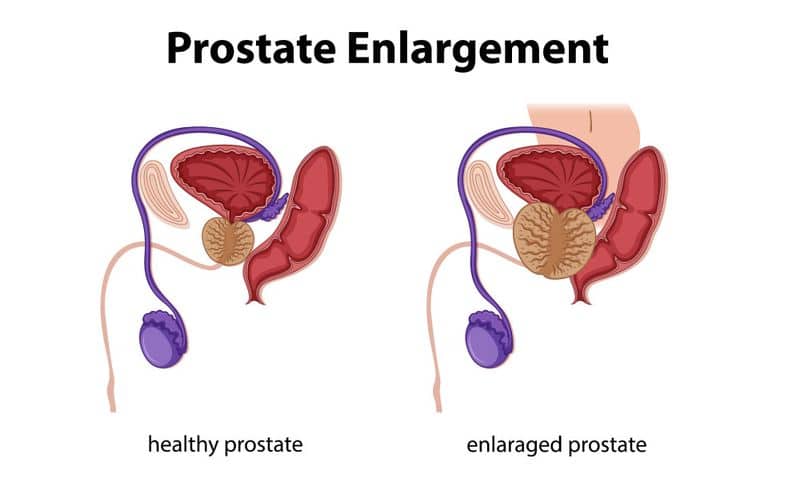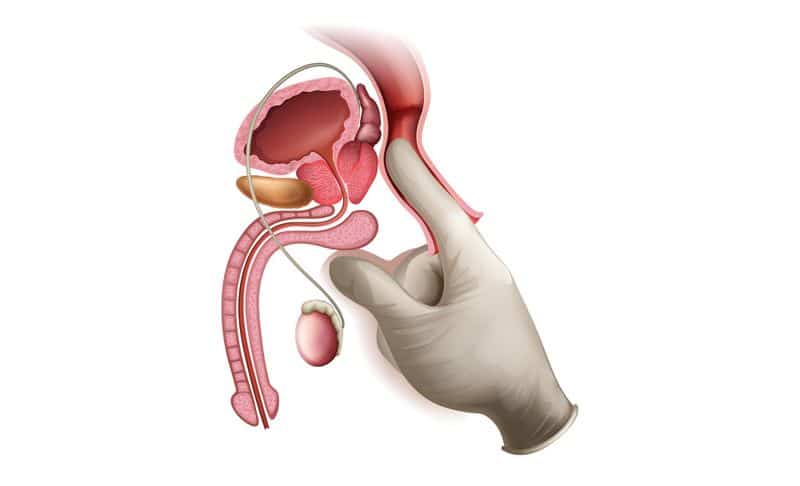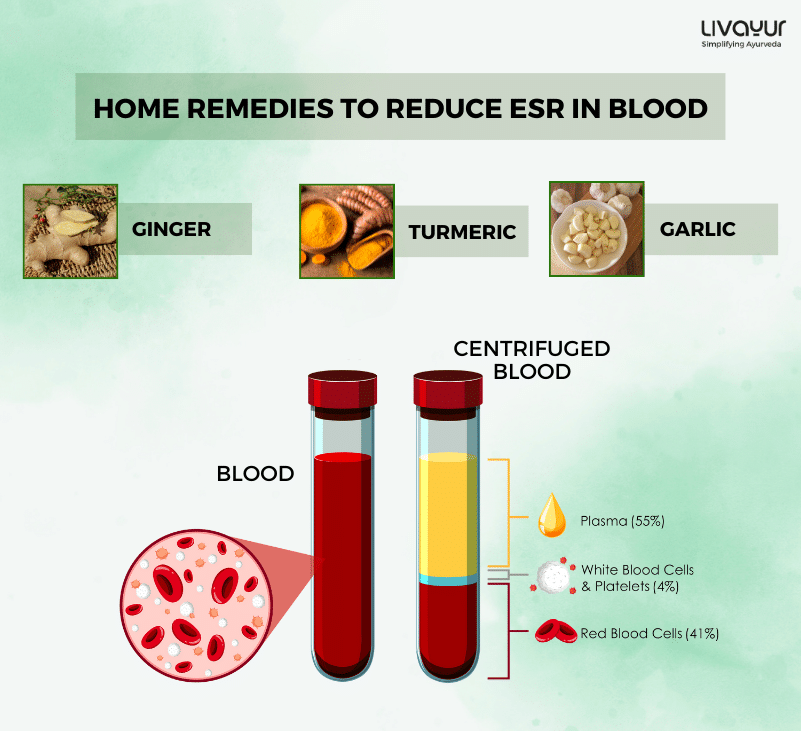
Have you heard of enlarged prostate problems? It is a very common issue among aged males. The prostate gland is a walnut-shaped gland located below the bladder and in front of the rectum in males.
The prostate gland produces fluid that nourishes and transports sperm. Prostatomegaly, also known as an enlarged prostate or Benign Prostatic Hyperplasia (BPH) – is a common condition that occurs as men age. [1] In other words, prostatomegaly means an enlarged prostate gland in males.
In this article, we will discuss the Prostatomegaly symptoms, stages, causes, diagnosis, and prostatomegaly treatment.
What are the Symptoms of Prostatomegaly
“Since prostate enlargement happens gradually, men often think more frequent trips to the bathroom are a natural part of aging.”
-Dr. Howard LeWine (Chief editor at Harvard Health Publishing & assistant professor of medicine at Harvard-affiliated Brigham and Women’s Hospital)
The symptoms vary depending on the severity of the condition. Some men with an enlarged prostate may experience no symptoms at all. However, as the prostate gland continues to grow, it can put pressure on the urethra, the tube that carries urine from the bladder out of the body, leading to the following symptoms:
1. Frequent Urination
Men with prostatomegaly may experience the urge to urinate more often than usual, particularly at night. [1], [2]
2. Difficulty Urinating
An enlarged prostate can make it difficult for urine to flow out of the bladder, resulting in a weak or slow stream of urine, a stream that stops and starts, or the need to strain to urinate. [1], [2]
3. Incomplete Emptying of the Bladder
Men with prostatomegaly may feel like they need to urinate again soon after going to the bathroom because their bladder is not completely empty. [1], [2]
4. Urinary Incontinence
An enlarged prostate can cause urinary incontinence, which is the involuntary leakage of urine. [1], [2]
5. Blood in Urine
In rare cases, an enlarged prostate can cause blood to appear in the urine. [1], [2]
What are the different stages of Prostatomegaly
It can be classified into four stages based on the size of the prostate gland, as determined by a digital rectal exam or imaging tests like an ultrasound or MRI:
1. Stage I: The prostate gland is slightly enlarged, and there are no symptoms. [3]
2. Stage II: The prostate gland is moderately enlarged, and the patient may experience symptoms like difficulty urinating or a weak urine stream. [3]
3. Stage III: The prostate gland is significantly enlarged, and the patient experiences severe symptoms like frequent urination, inability to empty the bladder, and urinary incontinence. [3]
4. Stage IV: The prostate gland is extremely enlarged, and the patient experiences the most severe symptoms, like blood in the urine, bladder stones, or kidney damage. [3]
What are the Causes of Prostatomegaly
The exact cause of prostatomegaly is not fully understood. However, research suggests that changes in hormone levels as men age may play a role in the development of an enlarged prostate.
Specifically, an increase in the hormone dihydrotestosterone (DHT) may cause prostate cells to multiply, leading to an enlarged prostate. [2], [3] Other factors that may contribute include:
1. Age: It is more common in men over the age of 50. [2], [3]
2. Family History: Men with a family history of prostate problems are more likely to develop an enlarged prostate. [2], [3]
3. Lifestyle Factors: Smoking, obesity, alcoholism, and a diet high in red meat and dairy products may increase the risk of developing prostatomegaly. [2], [3]
How is Prostatomegaly Diagnosed

To diagnose prostatomegaly, a doctor will perform a physical exam, including a digital rectal exam, to check the size and shape of the prostate gland. The doctor may also order blood tests to check for prostate-specific antigen (PSA) levels, a protein produced by the prostate gland that can be elevated in men with prostate problems. [4]
Additional tests may include:
1. Urine Flow Study: This test measures the rate of urine flow and how completely the bladder empties. [4]
2. Ultrasound: An ultrasound uses high-frequency sound waves to produce images of the prostate gland. [4]
3. Cystoscopy: This procedure involves inserting a small, flexible tube with a camera into the urethra to examine the bladder and prostate gland. [4]
4. Biopsy: A biopsy involves taking a small sample of prostate tissue to test for cancer or other conditions. [4]
How to Treat Prostatomegaly
Prostatomegaly treatment depends on the severity of symptoms, the size of the prostate gland, and the patient’s overall health. Treatment options may include:
1. Watchful Waiting
In cases where the symptoms are mild, doctors may recommend a “watchful waiting” approach, which involves monitoring the patient’s condition and symptoms over time. In many cases, patients may recover without needing any active medical treatment. [3],[5]
2. Medications
Some medications, such as alpha-blockers and 5-alpha-reductase inhibitors, may cause the prostate gland to shrink or relax the muscles in the prostate and bladder neck, improving urine flow. [3], [5]
3. Minimally Invasive Procedures
Procedures like transurethral microwave thermotherapy (TUMT) or transurethral needle ablation (TUNA) use heat or radio waves to destroy or remove excess prostate tissue. [3], [5]
4. Surgery
In more severe cases, surgery may be necessary to remove the prostate gland or part of it. Common surgical procedures include transurethral resection of the prostate (TURP) or laser prostatectomy. [3], [5]
Ayurvedic Approach to Prostatomegaly
Ayurveda identifies two conditions, called Mootrakruchra and Mootraaghaata, which exhibit symptoms of Prostatomegaly. Mootrakruchra, or strangury, is characterized by excruciating pain during urination, whereas in Mootraaghaata, there is either a complete blockage or intermittent flow of urine during urination. [6]
In India, natural therapies have a long-standing history of promoting optimal prostate health. Gokshura (also known as Gokhru), scientifically named Tribulus Terrestris, has been traditionally used to treat urogenital conditions.

To prepare it, grind two teaspoons of the fruit coarsely and boil it in two cups of water until half of the water remains. Drink one cup of this preparation, optionally, with sugar and milk. Gokshura can also be boiled in milk. [6]
Two other botanicals, Varuna (Crataeva religiosa) and Punarnava (Boerhaavia diffusa), have also been shown to alleviate symptoms of Prostatomegaly. Clinical trials have demonstrated that both of these botanicals possess significant anti-inflammatory properties, particularly with regard to the genitourinary tract. [6]
Ayurvedic Prostatomegaly treatment can work in conjunction with conventional treatments to ease the symptoms of Prostatomegaly but cannot be used as a substitute for treating the condition. It is important to get a prostate examination regularly after the age of 55, follow the advice of your medical practitioner, and get the necessary treatment.
How to Prevent Prostatomegaly
While there is no surefire way to prevent prostatomegaly, there are some lifestyle changes men can make to reduce their risk of developing the condition. These include:
1. Eating a Healthy Diet
A diet that is high in fruits, vegetables, and whole grains and low in red meat and dairy products may reduce the risk of developing an enlarged prostate. [7] When it comes to consuming a prostate gland-friendly diet, you must also know what all foods need to be kept out of that diet plan.
Learn – How you can create a healthy and balanced diet
So, the foods to avoid if you have an enlarged prostate include food items like red meat, sugary foods, dairy food products, high-fat foods, processed foods, high-sodium foods, and deep-fried foods.
2. Exercising Regularly
Regular exercises, such as brisk walking, swimming, or cycling, can help maintain a healthy weight and reduce the risk of developing prostatomegaly. [7]
3. Quitting Smoking
Smoking has been linked to an increased risk of developing prostate problems, including prostatomegaly. [7]
4. Practising Good Hygiene
Good hygiene, including regular hand washing and avoiding contact with people who are sick, can help prevent urinary tract infections that can lead to prostatomegaly. [7]
Did you know?
There are some highly effective Yoga postures for improving prostate health. Yogasanas like Dhanurasana, Virasana, Janu Sirsasana, Baddha Konasana, and Supta Padangusthasana.
FAQs
1. Is prostatomegaly the same as prostate cancer?
No, prostatomegaly is not the same as prostate cancer. Prostatomegaly is a non-cancerous enlargement of the prostate gland, while prostate cancer is a malignant tumor that develops in the prostate gland. However, having prostatomegaly may increase the risk of developing prostate cancer.
2. How common is prostatomegaly?
Prostatomegaly is a very common condition, especially in men over the age of 50. It is estimated that up to 90% of men over the age of 80 may have some degree of prostatomegaly.
3. Are there any complications associated with prostatomegaly?
In some cases, prostatomegaly can lead to complications such as urinary tract infections, bladder stones, urinary retention, and kidney damage. It is important to seek medical attention if you are experiencing symptoms of prostatomegaly to prevent these complications from occurring.
4. How long does it take for prostatomegaly to develop?
The development of prostatomegaly varies from person to person and can take several years. However, it is more common in older men, and the risk of developing the condition increases with age.
5. Can prostatomegaly recur after treatment?
Yes, prostatomegaly can recur after treatment. Regular follow-up appointments with your doctor may be necessary to monitor your condition and adjust treatment as needed.
Conclusion
Prostatomegaly is a common condition that affects many men as they age. While the exact cause of the condition is not fully understood, changes in hormone levels and other factors like age, family history, and lifestyle factors may contribute to the development of an enlarged prostate.
If you are experiencing symptoms of prostatomegaly, it is important to see a doctor for an accurate diagnosis and appropriate treatment. By making certain lifestyle changes, such as eating a healthy diet, exercising regularly, quitting smoking, and practicing good hygiene, men may be able to reduce their risk of developing an enlarged prostate and other prostate problems.
Disclaimer:
This article is from an informational and modern medicine perspective only and does not constitute medical advice. Kindly seek the help of a trained medical practitioner before initiating any treatment.
References:
- Prostate Enlargement (Benign Prostatic Hyperplasia) – NIDDK (nih.gov)
- Benign Prostatic Hyperplasia (BPH): Symptoms, Diagnosis & Treatment – Urology Care Foundation (urologyhealth.org)
- Diagnosis and treatment of benign prostate hyperplasia in Asia – PMC (nih.gov)
- Enlarged Prostate (BPH) – Diagnosis and Treatment (radiologyinfo.org)
- Current Treatment for Benign Prostatic Hyperplasia – PMC (nih.gov)
- Various treatment options for benign prostatic hyperplasia: A current update – PMC (nih.gov)
- Prevention of Benign Prostatic Hyperplasia Disease – ScienceDirect


















Hey! I know this is kind of off topic but I was wondering which blog platform are you using for this
website? I’m getting tired of WordPress because I’ve had problems with hackers and I’m looking at alternatives
for another platform. I would be great if you could point me in the
direction of a good platform.
I truly enjoy reading through on this site, it contains good articles. “A short saying oft contains much wisdom.” by Sophocles.
Appreciate it for all your efforts that you have put in this. very interesting information.
Write more, thats all I have to say. Literally, it seems as though you relied on the video to make your point. You clearly know what youre talking about, why waste your intelligence on just posting videos to your weblog when you could be giving us something enlightening to read?
I real pleased to find this web site on bing, just what I was searching for : D too saved to favorites.
Valuable info. Lucky me I found your web site accidentally, and I am shocked why this coincidence did not came about in advance! I bookmarked it.
You actually make it appear so easy with your presentation but I to find this matter to be really something that I think I would by no means understand. It seems too complex and extremely broad for me. I am looking forward on your next submit, I will try to get the hold of it!
Hello There. I found your blog the usage of msn. That is a very neatly written article. I will make sure to bookmark it and return to read more of your helpful information. Thanks for the post. I’ll certainly return.
You actually make it seem really easy together with your presentation but I to find this matter to be actually something which I feel I would never understand. It kind of feels too complex and very large for me. I am looking forward in your next put up, I will try to get the hold of it!
Purdentix reviews
Purdentix
Purdentix reviews
Purdentix review
Purdentix
Purdentix review
The layout is visually appealing and very functional.
I’m really impressed by the speed and responsiveness.
It provides an excellent user experience from start to finish.
It provides an excellent user experience from start to finish.
The content is well-organized and highly informative.
This website is amazing, with a clean design and easy navigation.
The design and usability are top-notch, making everything flow smoothly.
This website is amazing, with a clean design and easy navigation.
The layout is visually appealing and very functional.
I’m really impressed by the speed and responsiveness.
The content is engaging and well-structured, keeping visitors interested.
The content is well-organized and highly informative.
This site truly stands out as a great example of quality web design and performance.
I love how user-friendly and intuitive everything feels.
The content is engaging and well-structured, keeping visitors interested.
I’m really impressed by the speed and responsiveness.
The design and usability are top-notch, making everything flow smoothly.
I’m really impressed by the speed and responsiveness.
I love how user-friendly and intuitive everything feels.
This website is amazing, with a clean design and easy navigation.
It provides an excellent user experience from start to finish.
A perfect blend of aesthetics and functionality makes browsing a pleasure.
The design and usability are top-notch, making everything flow smoothly.
The content is engaging and well-structured, keeping visitors interested.
It provides an excellent user experience from start to finish.
The content is engaging and well-structured, keeping visitors interested.
AQUASCULPT
This site truly stands out as a great example of quality web design and performance.
I’m really impressed by the speed and responsiveness.
It provides an excellent user experience from start to finish.
I’m really impressed by the speed and responsiveness.
A perfect blend of aesthetics and functionality makes browsing a pleasure.
The design and usability are top-notch, making everything flow smoothly.
The design and usability are top-notch, making everything flow smoothly.
This site truly stands out as a great example of quality web design and performance.
I’m really impressed by the speed and responsiveness.
This website is amazing, with a clean design and easy navigation.
The content is engaging and well-structured, keeping visitors interested.
I love how user-friendly and intuitive everything feels.
The content is engaging and well-structured, keeping visitors interested.
The layout is visually appealing and very functional.
The layout is visually appealing and very functional.
I’m really impressed by the speed and responsiveness.
It provides an excellent user experience from start to finish.
The design and usability are top-notch, making everything flow smoothly.
The content is well-organized and highly informative.
The content is well-organized and highly informative.
This website is amazing, with a clean design and easy navigation.
This site truly stands out as a great example of quality web design and performance.
A perfect blend of aesthetics and functionality makes browsing a pleasure.
It provides an excellent user experience from start to finish.
This site truly stands out as a great example of quality web design and performance.
I love how user-friendly and intuitive everything feels.
A perfect blend of aesthetics and functionality makes browsing a pleasure.
The design and usability are top-notch, making everything flow smoothly.
I’m really impressed by the speed and responsiveness.
ICE WATER HACK FOR WEIGHT LOSS
The content is engaging and well-structured, keeping visitors interested.
It provides an excellent user experience from start to finish.
It provides an excellent user experience from start to finish.
The content is well-organized and highly informative.
The layout is visually appealing and very functional.
I’m really impressed by the speed and responsiveness.
This website is amazing, with a clean design and easy navigation.
It provides an excellent user experience from start to finish.
The content is well-organized and highly informative.
The content is engaging and well-structured, keeping visitors interested.
The content is engaging and well-structured, keeping visitors interested.
This site truly stands out as a great example of quality web design and performance.
I love how user-friendly and intuitive everything feels.
The layout is visually appealing and very functional.
It provides an excellent user experience from start to finish.
Watching a sunset over the ocean is one of the most peaceful experiences in life. Nature has a way of reminding us how small but connected we all are.
Watching a sunset over the ocean is one of the most peaceful experiences in life. Nature has a way of reminding us how small but connected we all are.
Japan is definitely on my bucket list! The mix of tradition and modernity is fascinating, and the food alone is enough reason to visit.
Christopher Nolan’s storytelling is always mind-blowing. Every movie feels like a masterpiece, and the way he plays with time and perception is just genius.
Thanx for the effort, keep up the good work Great work, I am going to start a small Blog Engine course work using your site I hope you enjoy blogging with the popular BlogEngine.net.Thethoughts you express are really awesome. Hope you will right some more posts.
Man is said to seek happiness above all else, but what if true happiness comes only when we stop searching for it? It is like trying to catch the wind with our hands—the harder we try, the more it slips through our fingers. Perhaps happiness is not a destination but a state of allowing, of surrendering to the present and realizing that we already have everything we need.
The essence of existence is like smoke, always shifting, always changing, yet somehow always present. It moves with the wind of thought, expanding and contracting, never quite settling but never truly disappearing. Perhaps to exist is simply to flow, to let oneself be carried by the great current of being without resistance.
Man is said to seek happiness above all else, but what if true happiness comes only when we stop searching for it? It is like trying to catch the wind with our hands—the harder we try, the more it slips through our fingers. Perhaps happiness is not a destination but a state of allowing, of surrendering to the present and realizing that we already have everything we need.
If everything in this universe has a cause, then surely the cause of my hunger must be the divine order of things aligning to guide me toward the ultimate pleasure of a well-timed meal. Could it be that desire itself is a cosmic signal, a way for nature to communicate with us, pushing us toward the fulfillment of our potential? Perhaps the true philosopher is not the one who ignores his desires, but the one who understands their deeper meaning.
Friendship, some say, is a single soul residing in two bodies, but why limit it to two? What if friendship is more like a great, endless web, where each connection strengthens the whole? Maybe we are not separate beings at all, but parts of one vast consciousness, reaching out through the illusion of individuality to recognize itself in another.
If everything in this universe has a cause, then surely the cause of my hunger must be the divine order of things aligning to guide me toward the ultimate pleasure of a well-timed meal. Could it be that desire itself is a cosmic signal, a way for nature to communicate with us, pushing us toward the fulfillment of our potential? Perhaps the true philosopher is not the one who ignores his desires, but the one who understands their deeper meaning.
Even the gods, if they exist, must laugh from time to time. Perhaps what we call tragedy is merely comedy from a higher perspective, a joke we are too caught up in to understand. Maybe the wisest among us are not the ones who take life the most seriously, but those who can laugh at its absurdity and find joy even in the darkest moments.
Even the gods, if they exist, must laugh from time to time. Perhaps what we call tragedy is merely comedy from a higher perspective, a joke we are too caught up in to understand. Maybe the wisest among us are not the ones who take life the most seriously, but those who can laugh at its absurdity and find joy even in the darkest moments.
All knowledge, it is said, comes from experience, but does that not mean that the more we experience, the wiser we become? If wisdom is the understanding of life, then should we not chase every experience we can, taste every flavor, walk every path, and embrace every feeling? Perhaps the greatest tragedy is to live cautiously, never fully opening oneself to the richness of being.
If everything in this universe has a cause, then surely the cause of my hunger must be the divine order of things aligning to guide me toward the ultimate pleasure of a well-timed meal. Could it be that desire itself is a cosmic signal, a way for nature to communicate with us, pushing us toward the fulfillment of our potential? Perhaps the true philosopher is not the one who ignores his desires, but the one who understands their deeper meaning.
Excellent website. A lot of useful info here. I¦m sending it to some buddies ans additionally sharing in delicious. And certainly, thank you in your sweat!
I’ve been surfing online more than 3 hours today, yet I never found any interesting article like yours. It is pretty worth enough for me. In my opinion, if all webmasters and bloggers made good content as you did, the internet will be a lot more useful than ever before.
The cosmos is said to be an ordered place, ruled by laws and principles, yet within that order exists chaos, unpredictability, and the unexpected. Perhaps true balance is not about eliminating chaos but embracing it, learning to see the beauty in disorder, the harmony within the unpredictable. Maybe to truly understand the universe, we must stop trying to control it and simply become one with its rhythm.
If everything in this universe has a cause, then surely the cause of my hunger must be the divine order of things aligning to guide me toward the ultimate pleasure of a well-timed meal. Could it be that desire itself is a cosmic signal, a way for nature to communicate with us, pushing us toward the fulfillment of our potential? Perhaps the true philosopher is not the one who ignores his desires, but the one who understands their deeper meaning.
Hi this is kinda of off topic but I was wanting to know if blogs use WYSIWYG editors or if you have to manually code with HTML. I’m starting a blog soon but have no coding expertise so I wanted to get advice from someone with experience. Any help would be greatly appreciated!